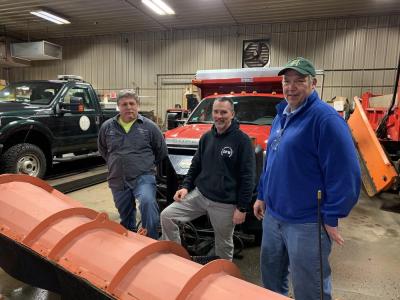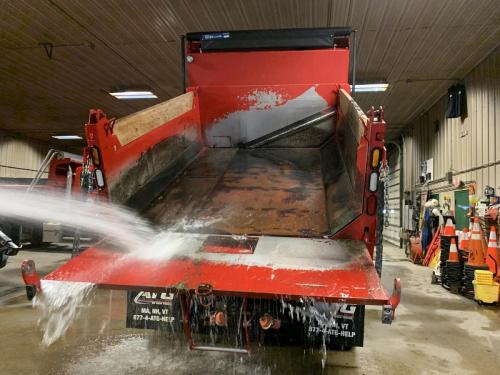Recipe for a Winter Storm: Salt, Molasses, and Snow Plow Pilots
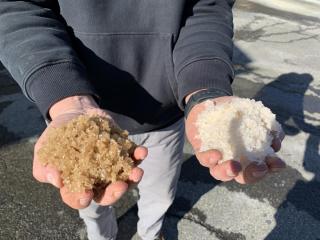
There's snow in the forecast next week, so when it’s 2 a.m. and you hear that heavy reassuring scrape on your street, outside, you'll know the town snowplows are making the rounds, as many rounds as it takes.
But these aren't your ordinary plow guys. These guys are municipal snow pilots. Inside the cab of their hulking high-up truck cabs, the setup could be the inside of a jet fighter. with high-tech digital controls and display screens, a collection of manual levers (which is which?) for raising and dropping plows and spinning rock salt onto the roads.
The re are danger alarms and flashing lights on board. Drivers are in steady communication with each other on the radio, swapping notes about road conditions and that guy who again left his car parked on Main Street in violation of the
re are danger alarms and flashing lights on board. Drivers are in steady communication with each other on the radio, swapping notes about road conditions and that guy who again left his car parked on Main Street in violation of the
town's winter overnight parking ban. Key to the job is tracking road surface temperatures, which are more important than air temperatures. The state Department of Transportation shares this added weather info with towns like GB, where Monument Valley Road may be colder than Main Street. A few degrees can mean rain or snow, ice or no ice depending on small temperature variations.
The driver on your street might be tag-teaming with another plow, following behind like a sweep car, adding salt (three of the town's 13 plows don’t have salt spreaders). Your snow plow pilot may have very limited visibility. He may have been at it for 24 or more hours, with a nap here and there. He can’t take a vacation between November and April—it just isn’t done. You don’t leave the other guys (and they are all guys at the moment) short-handed. That would upset the balance of snowplow pilot power.
A couple of weeks, ago, the town got a massive salt delivery of about 300,000 pounds. Before the next storm, each truck will be loaded with eight 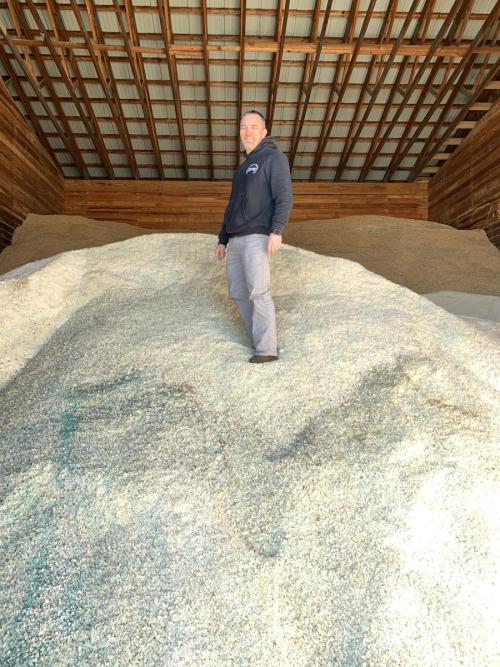 tons of salt. With 97 miles of roads in Great Barrington plow pilots must clear each lane (nearly 200 miles) during a storm, over and over again. Teams ply three different “zones” in town, and each zone pass takes about two hours. On a good day.
tons of salt. With 97 miles of roads in Great Barrington plow pilots must clear each lane (nearly 200 miles) during a storm, over and over again. Teams ply three different “zones” in town, and each zone pass takes about two hours. On a good day.
[John Malumphy is pictured with a recent salt delivery]
Back at the garage, the day after a storm, every truck gets a thorough bath. The gleaming red fleet, worth about $3 million in total, looks like it belongs on a showroom floor (this TLC helps these trucks last eight to 10 years). The drivers go home for shut-eye before they head back to do more cleanup at cemeteries and other nooks and crannies around town.
“Not everyone knows how hard these guys work, usually under the radar,” says said DPW Superintendent Joe Aberdale. “Still, our town residents are great in supporting our equipment needs, and we work hard to make every truck and chainsaw last.”
Says Highway Superintendent John Malumphy: “When we aren’t out salting and plowing, we’re maintaining vehicles, managing our salt supplies, taking care of all the other non-snow business around town and planning for spring.”
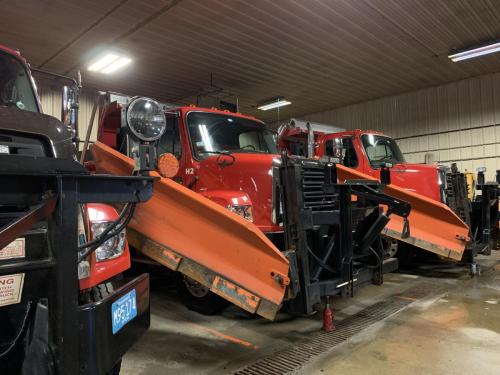
Most storms arrive with decent forewarning and the highway team develops a plan of attack. When the weather performs as expected, operations run fairly smoothly.
But the Christmas 2022 storm brought a winter curve ball of grand scale. Predicted as a modest white Christmas event, the snowfall quickly devolved into a fast-moving, icy blizzard. Temperatures dropped 40 degrees quickly and snow fell at three inches per hour. Three plow drivers were out sick with Covid and two trucks were out of service. It all would have been manageable if not for the surprise.
The plows were at it nonstop Friday, Dec. 23, and through Christmas Eve. Some Christmas shopping never got done. Sunday was a day off, and Monday Dec. 26, they were back at it mopping up the scene.
 Some people in Housatonic complained that their roads were plow-neglected. Aberdale and Malumphy replied that keeping with that storm was brutal, as traffic packed down fast-falling snow and temperatures dropped and ice developed. The underlying poor conditions in spots along Route 41 (the road is on the list for repaving) meant there were obstacles of trouble. Still, the highway team met for a post-mortem to test equipment, to see if a salt spreader wasn’t calibrated properly. All checked out, aside from staffing, truck issues, and the elements.
Some people in Housatonic complained that their roads were plow-neglected. Aberdale and Malumphy replied that keeping with that storm was brutal, as traffic packed down fast-falling snow and temperatures dropped and ice developed. The underlying poor conditions in spots along Route 41 (the road is on the list for repaving) meant there were obstacles of trouble. Still, the highway team met for a post-mortem to test equipment, to see if a salt spreader wasn’t calibrated properly. All checked out, aside from staffing, truck issues, and the elements.
[Pictured: Some of the town highway crew members on a recent sunny day]
Surprise fact: The town no longer uses sand on winter roads. Rock salt ist used to prep the roads and keep the ice and snow melting during storms. But plain rock salt is only good down to about 20 degrees. What to do?
Molasses, of course.
Molasses is used throughout cold-weather climates as a rock salt additive when road surface temperatures drop below 20 degrees. The sticky molasses helps the salt adhere to the road at lower temperatures, so now you know why you are smelling something sweet after your plow pilot passes by.
 Biggest hassle of being a plow driver, aside from multi-tasking in tough conditions?
Biggest hassle of being a plow driver, aside from multi-tasking in tough conditions?
“Some people don’t honor the overnight parking ban in winter,” said Vic Scapin, highway foreman. “There are some repeat offenders, and we call the cops. The cops will try to call the car owner, but nobody likes to get anyone’s car towed.”
Scapin and two other veteran plow pilots are nearing retirement (“34 winters will wear on you," said Scapin). They want to be able to pass on their experience to new recruits before they call it a day.
Come spring, the plows are put to bed. The plow pilots switch to warm weather work and the big red trucks are deployed as summer workhorse vehicles.
One day not long ago after a storm, the road crew showed up at the highway garage and found a bag of homemade cookies hanging on the door.
Please honor the town's overnight parking ban during next week's storm.
